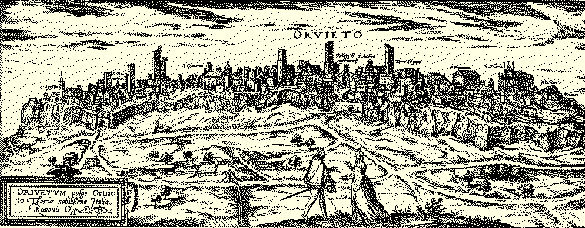|
3. ORVIETO -
GENERAL DESCRIPTION:
The traveller who approaches Orvieto by train or by car, sees
from a distance the city which rises on a plateau of volcanic
tuff, surrounded by a stupendous landscape of fields and vineyards.
The unbreachable walls appear to encircle the city rather than elevate
it, as though it were a fortress rising on the flat valley floor of
the river Paglia.

Because of its location, because of its Etruscan roots, because of
its charming medieval character, and above all because of its
celebrated Cathedral which is a gem of Gothic architecture, Orvieto is
one of Italy's most unique and interesting cities.
Orvieto is at an elevation of 1000 feet while the valley lies at
360 feet. There are 10,000 people who live in the city itself and
another 15,000 in the valley and in the surrounding hills.
4. HISTORY OF
ORVIETO:
The fascinating history of Orvieto begins in the
8-9th centuries B.C. when the rock was inhabited for the first time by
the Etruscans. The site of this settlement has in fact been identified
with the Etruscan center of Velzna ( Volsinii in Latin),
a city which began to flourish in the beginning of the 6th century
B.C. This economic prosperity was based mainly upon the production of
ceramics and on bronze work.
From a political point of view, Velzna was in the forefront of the
struggle against Roman expansionism, as a result of which in 254 B.C.,
having been occupied by the enemy armies, it was razed to the ground.
Following upon the destruction of the city came the dispersion of its
inhabitants who for the most part were forced to relocate to the
highlands overlooking the lake of Bolsena.
The name of the city appears to date back to this period of time.
In fact, Velzna became known as Volsinii Veteres (Ancient
Volsinii) or Urbs Vetus (the Old City) as distinguished from Volsinii
Novi (New Volsinii), which today is known as Bolsena.
At the time of the barbarian invasions, Orvieto was occupied by
Alaric the Goth and by Odovacar. Vitige took advantage of its
strategic natural position to create a defensive stronghold in the war
against the Byzantines. The imperial general Belisarius succeeded in
conquering the position after a bitter siege in 538 A.D.; it was
reoccupied temporarily by Totila before the final defeat of the Goths.
In 596 A.D. Orvieto was occupied by the longobard Agilulfo and had
its own bishop and later, in 606, its own counts. One of the counts of
Orvieto, Farolfo, within the framework of the religious rebirth
imposed by Emperor Otto III, and in collaboration with Saint Romualdo,
promoted the establishment of abbeys and monasteries in the
surrounding territories. In the 11th century Orvieto became a Comune
or City-State. The towers and palaces of noblemen of the area who had
relocated to the city began to be built.
The institution of the Comune is documented beginning in 1137.
Twenty years later a treaty was signed with Pope Adriano IV, which
increased papal influence in the city and gave way to the struggle
between the Guelfs or papal faction and the Ghibellines or imperialist
faction. This struggle was destined to extend over a long period of
time and marked the successive history of the city.
Orvieto soon became a Guelph stronghold of central Italy, holding
out against the repeated attacks of the Ghibellines who had been
expelled and the emperors Frederick I and Henry IV. In 1199, the Pope
appointed the first Podesta' of Orvieto, Piero Parenzo, who was
later killed in the civic battles between the opposing factions of the
Monaldeschi (Guelphs) and the Filippeschi (Ghibellines).
In the meantime, the jurisdiction of the Comune was extended from
Mount Amiata to Orbetello. The vitality of Orvieto can be seen in the
construction activity of the period. It is at this time that the
churches of San Lorenzo degli Arari, of San Francesco,
of San Domenico, of Santa Maria dei Servi were built, as
well as many public buildings such as the Comunal Palace, the Palazzo
del Capitano del Popolo, and the Papal Palace. And in 1290, the
building of the Cathedral was begun.
In the years 1281-1284, Pope Martino IV established a seat in
Orvieto, filling the city with Frenchmen against whom the citizens
rebelled. The battles were rekindled, and the Filippeschi or
Ghibellines were expelled in 1313. New factions arose, the Beffati and
the Malcorini, into which the Monaldeschi split. In 1334, Orvieto
found in Ermanno Monaldeschi della Cervara its first Lord, who reigned
until his death in 1337. In 1354 Cardinal Albornoz occupied Orvieto
subjecting the city to papal rule. However, Orvieto preserved its
comunal institutions, later becoming the capital of the fifth province
of the papal state.
In 1860 Orvieto was annexed to the Italian Kingdom, which later
became the Italian Republic.
|

